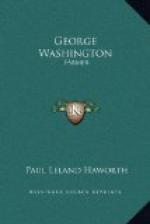Washington wrote to a friend that the drill would not “work to good effect in land that is very full either of stumps, stones, or large clods; but, where the ground is tolerably free from these and in good tilth, and particularly in light land, I am certain you will find it equal to your most sanguine expectation, for Indian corn, wheat, barley, pease, or any other tolerably round grain, that you may wish to sow or plant in this manner. I have sown oats very well with it, which is among the most inconvenient and unfit grains for this machine.... A small bag, containing about a peck of the seed you are sowing, is hung to the nails on the right handle, and with a small tin cup the barrel is replenished with convenience, whenever it is necessary, without loss of time, or waiting to come up with the seed-bag at the end of the row.”
As Washington says, the drill would probably work well under ideal conditions, but there were features of it that would incline, I have no doubt, to make its operator swear at times. There was a leather band that ran about the barrel with holes corresponding to those in the barrel, the purpose of the band being to prevent the seeds issuing out of more than one hole at the same time. This band had to be “slackened or braced” according to the influence of the atmosphere upon the leather, and sometimes the holes in the band tended to gape and admit seed between the band and the barrel, in which case Washington found it expedient to rivet “a piece of sheet tin, copper, or brass, the width of the band, and about four inches long, with a hole through it, the size of the one in the leather.”
Washington was, however, very proud of the drill, and it must have worked fairly well, for he was not the man to continue to use a worthless implement simply because he had made it. He even used it to sow very small seed. In the summer of 1786 he records: “Having fixed a Roller to the tale of my drill plow, & a brush between it and the barrel, I sent it to Muddy Hole & sowed turnips in the intervals of corn[5].”
[5] Another passage from his papers in which he mentions using his drill plow is also illustrative of the emphasis he placed upon having the seed bed for a crop properly prepared. The passage describes his sowing some spring wheat and is as follows: “12th [of April, 1785].—Sowed sixteen acres of Siberian wheat, with eighteen quarts, in rows between corn, eight feet apart. This ground had been prepared in the following manner: 1. A single furrow; 2. another in the same to deepen it; 3. four furrows to throw the earth back into the two first, which made ridges of five furrows. These, being done some time ago, and the sowing retarded by frequent rains, had got hard; therefore, 4. before the seed was sown, these ridges were split again by running twice in the middle of them, both times in the same furrow; 5. after which the ridges were harrowed; and, 6. where the ground was lumpy, run a spiked roller with a harrow




